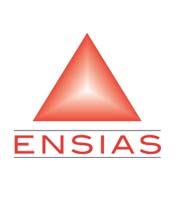- Accueil
-
L'Ecole
-
FORMATIONS
-
FORMATION INGENIEUR
-
Nouvelles filières offertes
- Ingénierie Intélligence Artificielle (2IA)
- Smart Supply Chain & Logistics (2SCL)
- Business Intelligence & Analytics (BI&A)
- Génie de la Data (GD)
- Génie Logiciel (GL)
- Ingénierie Digitale pour la Finance (IDF)
- Smart System Engineering (SSE)
- Data and Software Sciences (D2S)
- Cybersécurité, Cloud et Informatique Mobile (CSCC)
- REGLEMENT DES ETUDES DE L’ENSIAS CYCLE INGENIEUR
-
Nouvelles filières offertes
-
FORMATION INGENIEUR
- FORMATION CONTINUE
-
Recherche
- INTERNATIONAL
- ENTREPRISES
- VIE ESTUDIANTINE
- BIBLIOTHEQUE
LES DERNIÈRES INFORMATIONS
Performance Analysis of I/Q Imbalance With Hardware Impairments Over Hyper Fox's H-Fading Channels
| Titre | Performance Analysis of I/Q Imbalance With Hardware Impairments Over Hyper Fox's H-Fading Channels |
| Publication Type | Journal Article |
| Year of Publication | 2022 |
| Authors | Mouchtak, Y, F. Bouanani, E, Qaraqe, KA |
| Journal | IEEE Transactions on Wireless Communications |
| Volume | 21 |
| Pagination | 9519-9536 |
| Mots-clés | α, - μ, 5G mobile communication systems, Average symbol error rate, Channel capacity, Channel's capacity, Differential quadrature phase-shift-keying, Errors, Fading, Fading channels, Fadings channels, Gray coded differential quadrature phase-shift keying, Hardware, Hyper fox’, In-phase and quadrature-phase imbalances, Laga M turbulence, Má, Optical communication, Optical frequency conversion, Optical wavelength conversion, Outage probability, Outages, Phase shift, Phase shift keying, Pointing errors, Probability, Radiofrequencies, Receiver, Reliability analysis, Residual hardware impairment, S H-fading, Symbol error rates, Turbulence models, Wireless communications |
| Abstract | Impairments baseband model in-phase and quadrature-phase Imbalance (IQI) and Residual hardware impairments (RHI) are two key factors degrading the performance of wireless communication systems (WCSs), particularly when high-frequency bands are employed, as in 5G systems and beyond. The impact of either IQI or RHI on the performance of various WCSs has been investigated exclusively in a separate way. To fill this gap, in this paper, the joint effect of both IQI and RHI on the performance of a WCS subject to Hyper Fox's H-fading (HFHF) channel, is investigated. Such a fading model generalizes most, if not all, of well-known fading and turbulence models. To this end, closed-form expressions for the outage probability (OP), Average channel capacity (ACC) under constant power with optimum rate adaptation (ORA) policy, and average symbol error probability (ASEP) for both coherent and non-coherent modulation schemes are derived. Specifically, all the analytical expressions are derived for three different scenarios: (i) ideal Tx and Rx impaired, (ii) Tx impaired and ideal Rx, and (iii) both Tx and Rx are impaired. Further, asymptotic expressions for OP, ACC under ORA policy, and ASEP are obtained, based on which, insightful discussions on the IQI and RHI impacts are made. α-μ and Málaga M turbulence with pointing error distribution models have been considered as particular cases of the HFHF distribution. The analytical derivations, endorsed by simulation results, demonstrate that the RF impairments' effects should be seriously taken into account in the design of next-generation wireless technologies. © 2002-2012 IEEE. |
| URL | https://www.scopus.com/inward/record.uri?eid=2-s2.0-85131718569&doi=10.1109%2fTWC.2022.3177530&partnerID=40&md5=1b7b499e2631ae9a2916e24c3114412f |
| DOI | 10.1109/TWC.2022.3177530 |
Revues:
LIENS UTILES
Localisation
Contactez-nous
ENSIAS
 Avenue Mohammed Ben Abdallah Regragui, Madinat Al Irfane, BP 713, Agdal Rabat, Maroc
Avenue Mohammed Ben Abdallah Regragui, Madinat Al Irfane, BP 713, Agdal Rabat, Maroc
![]() Télécopie : (+212) 5 37 68 60 78
Télécopie : (+212) 5 37 68 60 78
![]() Secrétariat de direction : 06 61 48 10 97
Secrétariat de direction : 06 61 48 10 97
Secrétariat général : 06 61 34 09 27
Service des affaires financières : 06 61 44 76 79
Service des affaires estudiantines : 06 62 77 10 17 / n.mhirich@um5s.net.ma
CEDOC ST2I : 06 66 39 75 16
Résidences : 06 61 82 89 77
- Compteur de visiteurs:634,781
Education - This is a contributing Drupal Theme
Design by WeebPal.
Design by WeebPal.



































